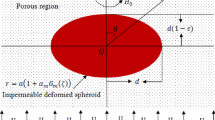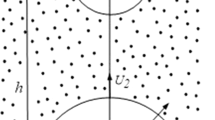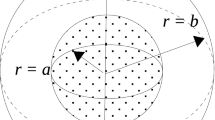Abstract
The major goal of this work is to analyze the magnetic effect on the creeping viscous flow past a porous spheroidal particle, a particle of slightly deformed spherical shape. Brinkman’s model is proposed to govern the flow in the porous media. Boundary value problem considers the conditions of continuity of velocity components, continuity of normal stresses, and stress jump boundary condition for tangential stress. A transverse magnetic field of uniform nature is applied to the flow. An expression for the drag force acting on the spheroidal particle is derived analytically. The effects of the physical parameters involved in the flow like permeability, deformation, Hartmann number’s, viscosity ratio, and stress jump coefficient parameters are visualized through graphs and tables. The applied magnetic field seems to suppress the flow of fluid that leads to the increase in the drag experienced on the porous spheroid. It is also observed that the increase in the deformation, stress jump, and permeability decreases the drag coefficient. Our results without magnetic effect match with the results reported earlier in the literature.






Similar content being viewed by others
References
Stokes, G.G.: On the effect of the internal friction of fluids on the motion of pendulums. Trans. Camb. Philos. Soc. 9, 8–106 (1851)
Darcy, H.P.G.: Les fontaines publiques de la ville de dijon. Proc. R. Soc. Lond. Ser. 83, 357–369 (1910)
Brinkman, H.C.: A calculation of viscous force exerted by flowing fluid on dense swarm of particles. Appl. Sci. Res. A1, 27–34 (1947). https://doi.org/10.1007/BF02120313
Beavers, G.S., Joseph, D.D.: Boundary condition at a naturally permeable wall. J. Fluid Mech. 30, 197–207 (1967). https://doi.org/10.1017/S0022112067001375
Saffman, P.G.: On the boundary condition at the surface of a porous medium. Stud. Appl. Math. 50, 93–101 (1971). https://doi.org/10.1002/sapm197150293
Ochoa-Tapia, J.A., Whitaker, S.J.: Momentum transfer at the boundary between a porous medium and a homogeneous fluid I, theoretical development. Int. J. Heat Mass Transf. 38, 2635–2646 (1995). https://doi.org/10.1016/0017-9310(94)00346-W
Ochoa-Tapia, J.A., Whitaker, S.: Momentum transfer at the boundary between a porous medium and a homogeneous fluid II, comparison with experiment. Int. J. Heat Mass Transf. 38, 2647–2655 (1995). https://doi.org/10.1016/0017-9310(94)00347-X
Zlatanovski, T.: Axi-symmetric creeping flow past a porous prolate spheroidal particle using the Brinkman model. Q. J. Mech. Appl. Math. 52(1), 111–126 (1999). https://doi.org/10.1093/qjmam/52.1.111
Saad, E.I.: Translation and rotation of a porous spheroid in a spheroidal container. Can. J. Phys. 88, 689–700 (2010). https://doi.org/10.1139/P10-040
Saad, E.I.: Stokes flow past an assemblage of axisymmetric porous spheroidal particle in cell models. J. Porous Media 15(9), 849–866 (2012). https://doi.org/10.1615/JPorMedia.v15.i9.40
Srinivasacharya, D., Krishna Prasad, M.: Creeping flow past a porous approximate sphere-Stress jump boundary condition. Z. Angew. Math. Mech. 91, 824–831 (2011). https://doi.org/10.1002/zamm.201000138
Srinivasacharya, D., Krishna Prasad, M.: Creeping flow past a porous approximately spherical shell: stress jump boundary condition. ANZIAM J. 52, 289–300 (2011). https://doi.org/10.1017/S144618111100071X
Srinivasacharya, D., Krishna Prasad, M.: Axisymmetric creeping flow past a porous approximate sphere with an impermeable core. Eur. Phys. J. Plus 128, 9 (2013). https://doi.org/10.1140/epjp/i2013-13009-1
Sherief, H.H., Faltas, M.S., Saad, E.I.: Slip at the surface of an oscillating spheroidal particle in a micropolar fluid. ANZIAM J. 55(E), E1–E50 (2013). https://doi.org/10.21914/anziamj.v55i0.6813
Srinivasacharya, D., Krishna Prasad, M.: Rotation of a porous approximate sphere in an approximate spherical container. Latin Am. Appl. Res. 45, 107–112 (2015)
Krishna Prasad, M., Kaur, M.: Stokes flow of viscous fluid past a micropolar fluid spheroid. Adv. Appl. Math. Mech. 9(5), 1076–1093 (2017). https://doi.org/10.4208/aamm.2015.m1200
Krishna Prasad, M., Bucha, T.: Steady viscous flow around a permeable spheroidal particle. Int. J. Appl. Comput. Math. 5, 109 (2019). https://doi.org/10.1007/s40819-019-0692-1
Cramer, K.R., Pai, S.I.: Magnetofluid Dynamics for Engineers and Applied Physicists. McGraw-Hills, New York (1973). https://doi.org/10.1017/CBO9780511626333
Davidson, P.A.: An Introduction to Magnetohydrodynamics. Cambridge University Press, London (2001)
Verma, V.K., Singh, S.K.: Magnetohydrodynamic flow in a circular channel filled with a porous medium. J. Porous Media 18(9), 923–928 (2015). https://doi.org/10.1615/JPorMedia.v18.i9.80
Yadav, P.K., Deo, S., Singh, S.P., Filippov, A.: Effect of magnetic field on the hydrodynamic permeability of a membrane built up by porous spherical particles. Colloid J. 79(1), 160–171 (2017). https://doi.org/10.1134/S1061933X1606020X
Saad, E.I.: Effect of magnetic fields on the motion of porous particles for Happel and Kuwabara models. J. Porous Media 21(7), 637–664 (2018). https://doi.org/10.1615/JPorMedia.v21.i7.50
Nazeer, M., Ali, N., Javed, T.: Natural convection flow of micropolar fluid inside a porous square conduit: effects of magnetic field, heat generation/absorption and thermal radiation. J. Porous Media 21(10), 953–975 (2018). https://doi.org/10.1615/JPorMedia.2018021123
Nazeer, M., Ali, N., Javed, T., Asghar, Z.: Natural convection through spherical particles of micropolar fluid enclosed in trapezoidal porous container: impact of magnetic field and heated bottom wall. Eur. Phys. J. Plus 133, 423 (2018). https://doi.org/10.1140/epjp/i2018-12217-5
Nazeer, M., Ali, N., Javed, T.: Numerical simulation of MHD flow of micropolar fluid inside a porous inclined cavity with uniform and non-uniform heated bottom wall. Can. J. Phys. 96(6), 576–593 (2018). https://doi.org/10.1139/cjp-2017-0639
Nazeer, M., Ali, N., Javed, T.: Numerical simulations of MHD forced convection flow of micropolar fluid inside a right angle triangular cavity saturated with porous medium: effects of vertical moving wall. Can. J. Phys. 97(1), 1–13 (2019). https://doi.org/10.1139/cjp-2017-0904
Ali, N., Nazeer, M., Javed, T., Razzaq, M.: Finite element analysis of bi-viscosity fluid enclosed in a triangular cavity under thermal and magnetic effects. Eur. Phys. J. Plus 2, 134 (2019). https://doi.org/10.1140/epjp/i2019-12448-x
Nazeer, M., Ali, N., Javed, T., Razzaq, M.: Finite element simulations based on Peclet number energy transfer in a lid-driven porous square container filled with micropolar fluid: impact of thermal boundary conditions. Int. J. Hydrogen Energy 44, 953–975 (2019). https://doi.org/10.1016/j.ijhydene.2019.01.236
Nazeer, M., Ali, N., Javed, T., Waqas Nazir, M.: Numerical analysis of full MHD model with Galerkin finite element method. Eur. Phys. J. Plus 134, 204 (2019). https://doi.org/10.1140/epjp/i2019-12562-9
Nazeer, M., Ahmad, F., Saeed, M., Saleem, A., Naveed, S., Akram, Z.: Numerical solution for flow of a Eyring-powell fluid in a pipe with prescribed surface temperature. J. Braz. Soc. Mech. Sci. Eng. 41, 518 (2019). https://doi.org/10.1007/s40430-019-2005-3
Nayak, M.K., Shaw, S., Ijaz Khan, M., Pandeyd, V.S., Nazeer, M.: Flow and thermal analysis on Darcy–Forchheimer flow of copper-water nanofluid due to a rotating disk: a static and dynamic approach. J. Mater. Res. Technol. 9(4), 7387–7408 (2020). https://doi.org/10.1016/j.jmrt.2020.04.074
Ijaz Khan, M., Khan, W.A., Waqas, M., Kadry, S., Chu, Y.-M., Nazeer, M.: Role of dipole interactions in Darcy-Forchheimer first order velocity slip nanofluid flow of Williamson model with Robin conditions. Appl. Nanosci. (2020). https://doi.org/10.1007/s13204-020-01513-9
Akram, S., Razia, A., Afzal, F.: Effects of velocity second slip model and induced magnetic field on peristaltic transport of non-Newtonian fluid in the presence of double-diffusivity convection in nano fluids. Arch. Appl. Mech. 90, 1583–1603 (2020). https://doi.org/10.1007/s00419-020-01685-4
Bilal, M., Nazeer, M.: Numerical analysis for the non-Newtonian flow over stratified stretching/shrinking inclined sheet with the aligned magnetic field and nonlinear convection. Arch. Appl. Mech. (2020). https://doi.org/10.1007/s00419-020-01798-w
Nabil, T.M., El-Dabe, M., Abou-Zeid, Y., Mohamed, M.A.A., Abd-Elmoneim, M.M.: MHD peristaltic flow of non-Newtonian power-law nanofluid through a non-Darcy porous medium inside a non-uniform inclined channel. Arch. Appl. Mech. (2020). https://doi.org/10.1007/s00419-020-01810-3
Krishna Prasad, M., Bucha, T.: Impact of magnetic field on flow past cylindrical shell using cell model. J. Braz. Soc. Mech. Sci. Eng. 41, 320 (2019). https://doi.org/10.1007/s40430-019-1820-x
Krishna Prasad, M., Bucha, T.: Effect of magnetic field on the steady viscous flow around a semipermeable spherical particle. Int. J. Appl. Comput. Math. 5, 98 (2019). https://doi.org/10.1007/s40819-019-0668-1
Krishna Prasad, M., Bucha, T.: Creeping flow of fluid sphere contained in a spherical envelope: magnetic effect. SN Appl. Sci. 1, 1594 (2019). https://doi.org/10.1007/s42452-019-1622-x
Krishna Prasad, M., Bucha, T.: Magnetohydrodynamic creeping flow around a weakly permeable spherical particle in cell models. Pramana J. Phys. 94, 24 (2020). https://doi.org/10.1007/s12043-019-1892-2
Krishna Prasad, M., Bucha, T.: Flow past composite cylindrical shell of porous layer with a liquid core: magnetic effect. J. Braz. Soc. Mech. Sci. Eng. 42, 452 (2020). https://doi.org/10.1007/s40430-020-02539-4
Krishna Prasad, M., Bucha, T.: MHD viscous flow past a weakly permeable cylinder using Happel and Kuwabara cell models. Iran. J. Sci. Technol. Trans. Sci. 44, 1063–1073 (2020). https://doi.org/10.1007/s40995-020-00894-4
Nield, D.A., Bejan, A.: Convection in Porous Media. Studies in Applied Mathematics, vol. 3. Springer, New York (2006)
Happel, J., Brenner, H.: Low Reynolds Number Hydrodynamics. Englewood Cliffs, Prentice-Hall (1965)
Avellaneda, M., Torquato, S.: Rigorous link between fluid permeability, electrical conductivity, and relaxation times for transport in porous media. Phys. Fluids A Fluid Dyn. (1991). https://doi.org/10.1063/1.858194
Neale, G., Epstein, N.: Creeping flow relative to permeable spheres. Chem. Eng. Sci. 28, 1865–1874 (1973). https://doi.org/10.1016/0009-2509(73)85070-5
Tiwari, A., Yadav, P.K., Singh, P.: Stokes flow through assemblage of non homogeneous porous cylindrical particle using cell model technique. Natl. Acad. Sci. Lett. 4(1), 53–57 (2018). https://doi.org/10.1007/s40009-017-0605-y
Author information
Authors and Affiliations
Corresponding author
Ethics declarations
Conflict of interest
The authors declare that they have no conflict of interest.
Additional information
Publisher's Note
Springer Nature remains neutral with regard to jurisdictional claims in published maps and institutional affiliations.
Appendices
Appendix A
On applying Eqs. (25) to (28) up to first order of \(\alpha _{m}\), we obtain the following equations
where
The leading terms of Eqs. (A.1)–(A.4) are equated to zero, and we get
Solving this system of Eqs. (A.5)–(A.8), the values of \(a_2\), \(b_2\), \(c_2\), and \(d_2\) are obtained. Now, Eqs. (A.1)–(A.4) are
To find the arbitrary constants \(A_n\), \(B_n\), \(C_n\), and \(D_n\), we use the following identities
In solving Eqs. (A.9)–(A.12), it is observed that
For \(n=m-2,m,m+2\), we have the following system of equations
where
Solving Eqs. (A.18)–(A.21) gives the expressions for \(A_n\), \(B_n\), \(C_n\), and \(D_n\) when \(n=m-2,m,m+2\).
Appendix B
The symbols present in Eqs. (41)–(47) are defined by
Rights and permissions
About this article
Cite this article
Madasu, K.P., Bucha, T. Effect of magnetic field on the slow motion of a porous spheroid: Brinkman’s model. Arch Appl Mech 91, 1739–1755 (2021). https://doi.org/10.1007/s00419-020-01852-7
Received:
Accepted:
Published:
Issue Date:
DOI: https://doi.org/10.1007/s00419-020-01852-7




